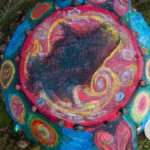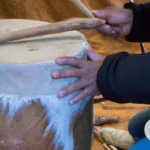Shamanism may seem like an esoteric practice, but it’s actually a powerful tool for self-discovery and healing. If you’re new to shamanic journeying, it can be overwhelming to know where to start. That’s where this beginner’s guide comes in – we’ll break down the principles of shamanism, explain the basics of journeying, explore shamanic healing techniques, and discuss the benefits and risks of this practice. By the end of this article, you’ll have a better understanding of what shamanism is, how it can be used, and whether it’s right for you. So grab a drum, light some sage, and get ready to embark on a journey of self-discovery and healing.
Understanding Shamanism

Shamanism is a spiritual practice that has been used by indigenous cultures for centuries. Shamanism is based on the belief that everything in the universe is alive and connected. The shaman is the intermediary between the spiritual and physical worlds and is able to communicate with spirits and ancestors. The purpose of shamanic practices is to heal the individual and the community by bringing balance and harmony to all aspects of life. Some of the principles of shamanism include the belief in the power of nature, the importance of community, and the recognition of the spiritual aspect of life. In shamanic healing, the shaman works with energy and spirit guides to address physical and emotional ailments. While shamanic journeying can be a powerful tool for healing, there are also risks involved, such as encountering negative entities or becoming lost in the spiritual realm. By using proper preparation and techniques, however, these risks can be minimized. To learn more about shamanic journeying for healing, check out resources such as /shamanic-journey-spirit-guides-healing/ or /shamanic-breathwork-healing/.
What is Shamanism?
Shamanism is a spiritual practice that has been around for thousands of years. It is an ancient tradition that revolves around the belief that everything in the world has a spirit. Shamans, the practitioners of shamanism, interact with the spiritual world to gain insights and guidance. They believe that the spiritual world is just as real as the physical world and that they can communicate and work with spirits to affect change in their lives and in the lives of others.
Shamanism is a tradition that recognizes the power of spiritual healing. Indigenous cultures have practiced shamanism for centuries as a way of improving their physical, mental, and emotional health. Shamans believe that everything, including sickness, has a spiritual cause or root. In order to heal the body, a shaman may need to work with the spirit realm to address the underlying spiritual cause of the ailment. By using shamanic techniques, a shaman can bring harmony and balance back to the individual’s life and restore health and well-being.
Shamanism provides a unique perspective on the world. It emphasizes the interconnectedness of all things, including the physical and spiritual world. Shamanism suggests that everything in the universe has a purpose, and everything is related. By tapping into this spiritual connection, shamans can gain insights, guidance, and healing for themselves and others.
The practice of shamanism is diverse, as it can take on different forms within different cultures. But at the heart of it, there is always a spiritual connection between the shaman and their spirit guides. These spirit guides can be animals, ancestors, or spirits of the earth. They act as helpers, providing the shaman with insights and guidance as they go about their spiritual work.
Shamanism can be used to address a wide range of issues, from spiritual growth and personal development to healing physical ailments and emotional trauma. By recognizing the interconnectedness of all things and tapping into the power of the spiritual world, shamans can provide profound healing and guidance for those who seek it.
If you’re interested in learning more about shamanic healing and journeying, be sure to check out these related articles:
“Shamanic Journeying for Trauma Release”,
“Healing Physical Ailments with Shamanic Journeying”,
“Healing with the Spirit Realm”, and
“Shamanic Journeying Techniques for Healing”.
Principles of Shamanism
Shamanism is based on several fundamental principles that guide the practice of this ancient spiritual tradition. One of the main principles is the belief in the interconnectedness of all things. Shamans view everything in the world, whether it be living or non-living, as interconnected and part of the same whole. This principle forms the foundation of shamanic healing practices.
Another important principle of shamanism is the belief in spirit guides. These are benevolent spiritual entities that help to guide and protect practitioners during their shamanic journeys. Spirit guides are believed to provide insight and wisdom that can help individuals to overcome personal challenges, connect to their higher selves, and find their life path and purpose.
Shamanism also emphasizes the importance of the natural world and the cycles of life and death. Practitioners of shamanism believe that the natural world contains a wealth of knowledge and wisdom that can help to heal and guide individuals. They also recognize the importance of death as a natural part of the cycle of life, and view it as a transformative process that can bring about spiritual growth for both the living and the dead.
Finally, shamanism places great importance on the power of intention and visualization. Practitioners believe that through focused intention and visualization, individuals can create positive change both within themselves and in the world around them. By focusing their thoughts and energies on a desired outcome, individuals can tap into their innate power to bring about healing, transformation, and spiritual growth.
The principles of shamanism reflect a profound respect for the interconnectedness of all things, a reverence for the natural world, and a deep commitment to healing and transformation. These principles continue to guide shamanic practice today, offering powerful tools and insights for those seeking to connect with their spiritual selves and the world around them.
Shamanic Beliefs
Shamanic beliefs are based on the understanding that everything in the universe has energy and is interconnected. A shaman believes that they can communicate with spirits and entities in the spiritual realm to gain knowledge and wisdom to help heal people in the physical world. Here are some key beliefs of shamanism:
| Belief | Description |
|---|---|
| Spirits | Shamans believe in the existence of spirits and that they play a role in the physical world. They believe that everything, from plants to animals to rocks, has a spirit or energy. |
| Worldview | Shamanic belief is rooted in the idea that the natural world and spiritual world are interconnected, and that everything in the universe is part of a larger whole. Everything has a purpose and a role to play in the grand scheme of things. |
| Energy | Shamans believe that energy is all around us and can be harnessed for healing and other purposes. They believe in the existence of a life force energy that runs through all living things. |
| Healing | Healing is a central belief in shamanism. Shamans believe that by communicating with spirits and accessing other realms of consciousness, they can help people heal from physical, emotional, and spiritual ailments. |
| Cosmic Balance | Shamans believe that in order for the universe to function properly, there must be a balance between all things. Good and evil, light and dark, male and female, all these elements must exist in harmony for the world to thrive. |
These beliefs are not meant to be taken as literal truths, but rather as metaphors for the interconnectedness of all things. Shamans use them to guide their understanding of the world and to help them in their healing practices.
Journeying 101
Journeying is a fundamental practice in shamanism. It involves shifting one’s consciousness to access the spirit realm and seek guidance or healing from spirit allies and ancestors. Journeying is achieved through a state of deep relaxation, often induced by drumming or other rhythmic sounds. During a journey, the participant meets with spirit guides, receives messages, and experiences profound spiritual insights. To begin journeying, it is essential to prepare oneself both physically and mentally. This includes finding a quiet and safe space for the practice, setting intentions, cleansing the space and oneself, and establishing a connection with one’s spirit allies. With consistent practice and an open heart, journeying can become a powerful tool for personal growth and spiritual insight.
What is Journeying?
Journeying in shamanism refers to an altered state of consciousness in which the shaman or practitioner enters to communicate with the spiritual world and receive wisdom and guidance. This typically involves a form of meditation or trance induced by drumming, rattling or other repetitive sounds.
During a journey, the shaman may encounter spiritual guides, power animals, ancestors, or other forms of spiritual entities. They may also visit different realms, such as the Upper, Lower, and Middle worlds, which have different characteristics and offer different types of spiritual experiences.
Journeying is an essential aspect of shamanism, as it allows the practitioner to directly experience and interact with the spiritual world, gaining insight and knowledge to help heal oneself and others. It offers a way to access deeper levels of consciousness and explore the mysteries of the universe.
While journeying, it is important to remain grounded and connected to the physical world, as well as to maintain respect and gratitude towards the spiritual entities encountered. With practice, journeying can become a powerful tool for personal transformation and spiritual growth.
The Basics of Shamanic Journeying
Shamanic journeying is an essential technique used in shamanism for accessing the spiritual realms and connecting with spiritual allies, guides, and ancestors. To embark on a shamanic journey, one must enter into a trance-like state achieved through a rhythmic drumbeat or some other form of repetitive sound, which synchronizes with the brainwaves.
The journeyer must find a comfortable and safe place to lie down or sit and close their eyes. While in this state, the journeyer is open to other realms and spiritual dimensions. It is essential to maintain focus and intention during the journey, as it can be easy to get distracted or lose connection with the spirit world.
Journeyers begin their journey by setting a clear intention and asking their spirit guides or allies to help them. They then visualize traveling down into the earth or up into the sky, passing through different layers of the spiritual realms. In this state, journeyers are open to receiving visions, messages, and guidance from their guides and allies.
The journeyer must remain aware of their surroundings and remember the journey details once they return to their ordinary state of consciousness. Writing down notes or using art forms to capture the journey’s experience can be helpful in reinforcing the experience’s memory.
Shamanic journeying is a personal and profound experience that can help individuals unlock their spiritual potential. However, like any practice, it takes time and consistency to develop a strong connection to the spirit world and reap the full benefits of shamanic journeying.
Preparing for Journeying
Preparing for journeying is an essential part of the shamanic practice. The first step in preparing for journeying is finding a peaceful and quiet place where you won’t be disturbed. You should also ensure that you have no distractions or interruptions during your journey.
Once you have found the ideal location, it’s time to focus your mind. You may want to set an intention for your journey or perform a ritual or smudging to help clear your energy field. This will help you establish a deeper connection with the spiritual world and enhance your journeying experience.
Next, you should get into a comfortable position, whether you choose to sit or lie down. Then, take deep breaths to help you relax and clear your mind. You should also set your intention and state it clearly to yourself.
It’s important to remember that journeying can be a very intense and emotional experience. It’s essential to create a safe and supportive space. This may include creating a protective circle or inviting spiritual guides to accompany you during your journey.
Before beginning your journey, it’s also important to set a time limit for how long to journey. You should choose a duration that feels comfortable for you as a beginner, perhaps starting with just 15-20 minutes.
Finally, end your preparation by stating that you are ready to journey and opening yourself up to the experience. Trust yourself and the journey that will unfold.
Preparing for journeying is an essential step to get the most out of the shamanic experience. By finding a quiet place, focusing your mind, setting an intention, creating a safe space, and setting a time limit, you can ensure that you have a successful and transformative journey.
Entering the Journey
Entering the journey is a crucial step in Shamanic journeying. It requires a deep sense of surrender and trust to the process. To enter the journey, create a sacred space that feels safe and conducive to meditative practice. Dim the lights, light some candles and incense, and sit or lie down comfortably.
Close your eyes and take a few deep breaths, feeling your body relax with each exhalation. Bring your attention to your heart center and set your intention for the journey. It can be a question you want to ask, a problem you want to solve, or simply a desire to connect with your guides.
Next, visualize an entrance into the journey, such as a tunnel, a cave, a tree, or a portal. Trust that this entrance will lead you to the appropriate realm and guides who can help you on your journey.
As you approach the entrance, be open to any sensations, images, or sounds that come up. If you encounter any resistance or fear, acknowledge them without judgment and ask your guides for support and protection.
Once you feel ready, take a deep breath and step into the entrance with faith and excitement. Allow yourself to be carried by the journey and trust that you will receive whatever you need at this time.
Remember to keep your intention in mind and listen attentively to your guides throughout the journey. Don’t force any particular outcome or experience, but let the journey unfold naturally and organically.
Entering the journey can be a profound and transformative experience, but it requires practice, patience, and courage to surrender to the unknown. With time and dedication, you can develop a deep and meaningful relationship with your guides and access the wisdom and healing power of Shamanic journeying.
The Journey Experience
During the journey experience, the shamanic practitioner enters a state of altered consciousness to communicate with the spirit world. This is often done with the help of a drum, rattle, or other percussive tool to create a trance-like state. Once entered, the journeyer can explore spiritual realms and meet with spirit guides or power animals.
Some common experiences during shamanic journeying include:
- Visions: During a journey, a practitioner may experience vivid visuals, which can offer insights into their healing process or guidance from spirit guides.
- Sensations: Sensations such as heat, cold, or pressure may be felt during journeying and can indicate something significant about the journey or the practitioner’s energy blockages or imbalances.
- Physical Movements: A journeyer may feel compelled to move their body during the experience, such as swaying or dancing. This can be a way of releasing energy blockages or connecting with a spirit guide.
- Emotions: The journey experience can often bring up strong emotions such as fear, sadness, or joy. These emotions may be related to the journey itself or to the practitioner’s healing process.
- Messages: During the journey, spirit guides may communicate with the practitioner through symbols or messages. These can offer guidance or insights into the practitioner’s life and path.
It’s important to trust the journey and allow it to unfold naturally without expectations or resistance. The experience may vary for each individual, and it’s important to honor and respect these differences. Once the journey is complete, it’s important to take time to integrate and reflect on the experience before returning to regular consciousness.
Returning from the Journey
Returning from a shamanic journey is just as important as entering it. As you return to ordinary reality, take your time to reorient yourself. Gradually open your eyes and reconnect with the physical world around you. Stay still for a few minutes, and reflect on your experience. What did you see and feel? What message did you receive?
It is normal to feel disoriented or even emotional as you return. Honor these feelings as part of the journey, and allow yourself to feel them fully. Don’t rush into anything immediately after you return from your shamanic journey. Instead, take some time to process your experience.
It is also a good idea to record your experience in a journal. This way, you can refer to it later and analyze it more in-depth. Write down anything that comes to mind, including any messages or insights you received.
Remember, shamanic journeying is a personal practice, and each journey is unique. Your experience may differ from your friends or other practitioners. Don’t compare your journey to anyone else’s. Instead, focus on what you learned and how you can use it to improve your life.
Once you have fully returned to ordinary reality, take care of yourself. Drink some water, eat some food if you’re hungry, and give yourself time to rest. You may also want to smudge yourself with sage or another smudging herb to cleanse your energy field.
Returning from a shamanic journey is just as important as the journey itself. Take your time to reorient yourself, process your experience, and record any insights in a journal. Honor your emotions, stay grounded, and take care of yourself afterwards.
Journeying Practice
Journeying Practice: Journeying is a powerful tool for healing, personal growth, and spiritual development. It is a practice that requires dedication, commitment, and patience. Here are some tips to help you deepen your journeying practice:
1. Set an intention: Before you journey, take the time to set an intention for what you want to focus on. This could be a question you want answers to, a problem you want to solve, or a quality you want to develop.
2. Create a sacred space: Create a physical space in your home that is dedicated to your journeying practice. This could include candles, crystals, feathers, or any other objects that hold spiritual significance for you.
3. Use music: Music can be a powerful tool for journeying. Choose music that resonates with you and helps you relax. Experiment with different types of music to find what works best for you.
4. Use a shamanic drumming track: Shamanic drumming is a specific type of music that is used to induce a trance state for journeying. Look for a shamanic drumming track that is between 7 and 15 minutes long and listen to it with headphones.
5. Practice regularly: Consistency is key when it comes to journeying. Set aside time each week to practice, even if it’s only for a few minutes.
6. Keep a journal: After each journey, take the time to write down your experiences and any insights you gained. This will help you track your progress and deepen your understanding of your journeying practice.
Remember, journeying is a deeply personal practice, and there is no right or wrong way to do it. Trust your intuition and allow yourself to be guided by your inner wisdom. With practice, you will develop a deeper connection to the spirit world and experience transformational healing and growth.
Healing with Shamanism

Shamanism has been used for centuries as a powerful method of healing incorporating spiritual practices to help individuals achieve balance and harmony. Shamanic Healing Techniques involve using a variety of tools such as drums, rattles, and crystals to create a healing environment and experience. Shamans believe that illness is often a result of spiritual
Subscribe to Our Newsletter
Sign up to receive the latest news and updates.
Shamanic Healing Techniques
Shamanic healing techniques are focused on restoring balance and harmony to a person’s body, mind, and spirit. These techniques utilize the power of nature, spirits, and religious symbols to address various mental and physical illnesses. There are several shamanic healing techniques, and the most commonly used ones include the following:
Soul retrieval: This shamanic healing technique addresses the loss of life force or vitality due to traumatic experiences or emotional stress. During the healing process, the shaman journeys to the spirit world to retrieve the missing soul fragments and bring them back to the person. This technique helps the person to feel whole again and reclaim their life force energy.
Extraction: This shamanic healing technique involves removing spiritual intrusions or negative energies from a person’s body using specific methods such as suction or hand movements. It aims to clear any blockages and restore balance to the person’s energy field. Shamanic practitioners believe that disease and illness manifest in the energetic body first before manifesting physically, and extraction helps to remove harmful energies before they cause physical harm.
Ceremony and ritual: Shamanic healing ceremonies and rituals are powerful methods that involve offering prayers, songs, and dances to spirits and deities. These ceremonies and rituals aim to bring balance and harmony to a person’s physical and spiritual energies, leading to healing and restoration.
Divination: Shamanic divination involves seeking guidance and answers to life’s questions through various methods such as reading the patterns in nature or interpreting the messages from spiritual beings. This technique helps a person to gain insight into their lives and make well-informed decisions.
Plant medicine: Shamanic healers often use plant medicine to address various physical and spiritual ailments. These plant medicines range from herbs, mushrooms, to other natural substances, and are taken under the guidance of a trained shaman who knows their proper usage and dosage.
Shamanic healing techniques can be powerful tools for achieving healing and balance in one’s life. However, it’s essential to note that these techniques should be utilized under the guidance and supervision of trained shamanic practitioners to avoid any potential harm or risks. With the right approach and guidance, shamanic healing techniques can help individuals achieve optimal health and wellness.
Understanding Energy and Illness
Understanding Energy and Illness in Shamanism is based on the fundamental principle that all things, including humans and their bodies, are made up of energy. Shamanic healers believe that this energy is responsible for our physical, emotional, and mental well-being. Understanding energy and illness is therefore crucial for the successful practice of shamanic healing.
The concept of energy centers, known as chakras, is central to shamanic healing. There are seven chakras in the body, each with its unique purpose and energy flow. These energy centers correspond to specific organs and glands in the body and are connected through a complex network of energy pathways known as meridians.
Shamanic healers believe that when energy flow is blocked or disrupted, it leads to illness or disease. Blockages and imbalances can be caused by a variety of factors, including stress, trauma, negative emotions, and environmental factors.
To heal these energy imbalances, shamanic healers use a variety of techniques, including energy field clearing, chakra balancing, and soul retrieval. Energy field clearing involves removing negative energy and attachments from the patient’s energetic field. Chakra balancing aims to restore balance and harmony to the patient’s chakras. Soul retrieval involves bringing back parts of the patient’s soul that may have been lost due to trauma or other negative experiences.
Shamanic healing is also focused on the root cause of illness rather than just treating symptoms. By understanding the energy imbalances that have led to illness, shamanic healers can address the underlying issues to achieve long-term healing.
It is important to note that shamanic healing is not a substitute for medical care. It is a complementary practice that can be used alongside conventional medicine to enhance healing. Patients should always consult with their doctor before seeking shamanic healing.
Understanding energy and illness is a critical aspect of shamanic healing. By addressing energy imbalances and their underlying causes, shamanic healers can bring about a holistic healing of the body, mind, and spirit.
Benefits and Risks of Journeying
Shamanic journeying can provide a range of physical, emotional, and spiritual benefits, but it also comes with some risks to consider. Benefits of journeying include the opportunity for self-discovery, greater intuition, enhanced creativity, and relief from anxiety, depression, and stress. Additionally, shamanic journeying can aid in healing physical ailments, offer insights into one’s life purpose, and provide connection to the spiritual realm. However, there are also some risks to consider when journeying, such as spirit possession, emotional overwhelm, and the potential for encountering challenging or frightening experiences. It is important for beginners to approach journeying with caution and guidance from an experienced shamanic practitioner or teacher, and to always prioritize safety and self-care during and after a journey.
The Benefits of Shamanic Journeying
There are many benefits to practicing shamanic journeying. First and foremost, it allows for a deep connection with one’s self and the universe around them. By entering an altered state of consciousness, people are able to tap into their inner wisdom and connect with their spirit guides. This can provide clarity and insight into one’s life path and help to navigate challenges and obstacles.
Another benefit of shamanic journeying is the healing that can occur during the journeys. This can come in the form of emotional, mental, or physical healing. Journeying can also help to identify the root cause of illness or pain, allowing for targeted healing work to take place.
Shamanic journeying can also help to reduce stress and anxiety. By entering a relaxed state during a journey, people are able to release tension and worry, leading to a sense of calm and peacefulness. This can also lead to improved sleep and overall wellbeing.
Shamanic journeying can provide a sense of purpose and direction in life. By connecting with spirit guides and receiving guidance, people are able to gain clarity on their life path and purpose. This sense of direction can lead to increased motivation and focus in achieving goals and living a fulfilling life.
Shamanic journeying has many benefits for those who practice it. From a deeper connection with one’s self and universe to healing and stress reduction, the practice can lead to a more fulfilling and purposeful life.
The Risks of Shamanic Journeying
Shamanic journeying can be a powerful tool for healing and self-discovery. However, like any spiritual practice, there are risks involved that should be taken into consideration before starting the journey.
One of the biggest risks of shamanic journeying is the possibility of encountering negative entities or energies during the journey. These entities can attach themselves to the individual and cause harm, both mentally and physically. It is important to protect oneself before embarking on the journey by creating a sacred space and calling upon benevolent spirits for guidance and protection.
Another risk is the possibility of becoming too reliant on the journey as a means of escape. If an individual is not dealing with their issues in the physical world and only using the journey as a form of avoidance, it can lead to further harm and dysfunction in their daily life.
There is also the risk of delving too deeply into the spiritual realm and losing touch with reality. It is important to maintain a balance between the spiritual and physical worlds and not get lost in the journey.
Some individuals may experience a resurgence of trauma or negative emotions during the journey. It is important to have a support system in place and work with a trusted shamanic practitioner to process and integrate any difficult experiences that arise during the journey.
Finally, there is the risk of cultural appropriation. It is important to respect and honor the traditional cultures from which shamanic practices originate and not exploit them for personal gain or profit.
While shamanic journeying can be a transformative and healing experience, it is important to approach it with caution and awareness of the potential risks involved. By protecting oneself and maintaining a balance between the spiritual and physical worlds, one can safely navigate the journey and reap the benefits it has to offer.
Conclusion
As we come to the conclusion of this beginner’s guide to shamanic journeying for healing, it’s important to remember that shamanism isn’t just a practice, it’s a way of life. Integrating shamanic practices into your daily routine can bring a sense of balance and connection to the world around you. It’s crucial to approach journeying with respect and caution, acknowledging both the benefits and risks that come with this powerful healing tool. Remember to continue your education and exploration of shamanic practices, and seek guidance from experienced practitioners. With time and dedication, journeying can become a transformative and enlightening experience for those who embark on the path. So, embrace the journey and allow the wisdom and healing power of shamanism to guide you towards a more harmonious existence.
Integrating Shamanic Practices into Daily Life
Integrating shamanic practices into daily life can be a powerful way to connect with the spiritual realm and cultivate a deeper sense of awareness and well-being. Here are some ways to incorporate shamanic practices into your daily routine:
| Practice | Description |
|---|---|
| Meditation | Take a few minutes each morning to sit quietly and focus on your breath. This can help you connect with your inner self and the spiritual realm. |
| Nature Walks | Spend time in nature, connect with the earth and the spirits of the land. Pay attention to the natural world around you and listen to the messages it has to offer. |
| Ceremonies and Rituals | Create a sacred space in your home where you can perform rituals or ceremonies to honor the spirits and ancestors. This can be as simple or elaborate as you like. |
| Dream Work | Keep a dream journal and pay attention to the symbols and messages that come through in your dreams. Use this information to guide your spiritual practice. |
| Offerings | Make offerings to the spirits and ancestors as a way of showing gratitude and building a relationship with them. This can be done in a variety of ways, such as lighting candles, burning incense, or leaving food offerings. |
| Journaling | Write down your thoughts and experiences related to your shamanic practice. This can help you track your progress, reflect on your journey, and gain deeper insights into your spiritual path. |
Remember that shamanic practices are deeply personal and can take many forms. It’s important to listen to your intuition and follow the path that feels right for you. By integrating shamanic practices into your daily routine, you can deepen your spiritual connection and live a more meaningful, fulfilling life.
Continuing Your Shamanic Journey
Continuing your shamanic journey is all about integrating the principles, beliefs, and practices of shamanism within your daily life. Here are some tips for continuing your shamanic journey:
- Practice regularly: Make shamanic journeying a regular practice. Set aside some time each week to journey and explore the spiritual realm.
- Connect with your spirit guides: Your spirit guides are always there to help and guide you. Connect with them regularly through journeying and meditation.
- Attend workshops and retreats: Attend workshops and retreats to learn more about shamanism and connect with other like-minded individuals.
- Learn new techniques: Explore new shamanic healing techniques and practices to deepen your understanding of shamanism.
- Journal: Keep a journal to document your experiences and insights. Reflect on your journeying experiences and how they have impacted your life.
- Live in alignment with shamanic principles: Bring shamanic principles into your everyday life. Live in harmony with nature, practice gratitude, and cultivate a strong connection with your spirituality.
- Teach others: Share your knowledge and experiences with others who are interested in shamanism. Teach others how to journey and inspire them to embark on their own shamanic journey.
Continuing your shamanic journey is a lifelong process of growth and development. By incorporating shamanic principles and practices into your daily life, you can deepen your spirituality and connect with the spiritual realm on a deeper level. Remember to always approach your shamanic journey with an open heart and mind, and trust that your spirit guides are always there to support and guide you.
Frequently Asked Questions
What is the goal of shamanic journeying?
The goal of shamanic journeying is to connect with the spirit world and gain guidance and wisdom for healing and personal growth.
Do I need any special equipment to journey?
No, you do not need any special equipment to journey. However, it is recommended to have a comfortable place to sit or lie down and a drum or rattle to help induce a trance state.
How do I know if I am journeying correctly?
You will know if you are journeying correctly if you are able to enter a trance state and connect with the spirit world. It may take some practice to fully develop your journeying skills.
Can anyone learn to journey?
Yes, anyone can learn to journey. It may take some practice and dedication to develop your skills, but with patience and persistence, you can become proficient in shamanic journeying.
Is shamanic journeying safe?
Shamanic journeying can be safe when practiced correctly. However, it is important to respect the power of the spirit world and approach your journeying practice with reverence and caution.
What are some common experiences during a shamanic journey?
During a shamanic journey, you may experience visual or auditory hallucinations, sensations of movement or flying, encounters with spirit guides or power animals, and deep insights or revelations.
How long should I journey for?
Journeying sessions can vary in length depending on your personal preference and experience. Beginners may want to start with shorter sessions of 10-20 minutes, while more experienced journeyers may journey for 30 minutes or longer.
Can shamanic journeying be used for physical healing?
Shamanic journeying can be used for physical healing by identifying the energetic root causes of illness and working with spirit allies to facilitate healing on a spiritual level.
Do I need to believe in shamanism for it to work?
You do not necessarily need to believe in shamanism for it to work, but it is important to approach your practice with an open mind and a willingness to connect with the spirit world.
How can I integrate shamanic practices into my daily life?
You can integrate shamanic practices into your daily life by cultivating a deeper connection with nature, practicing mindfulness and meditation, and incorporating ritual and ceremony into your routine.










